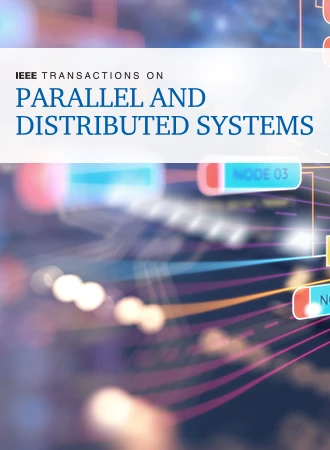Response Time Analysis and Optimal Priority Assignment for Global Non-Preemptive Fixed-Priority Rigid Gang Scheduling
IF 5.6
2区 计算机科学
Q1 COMPUTER SCIENCE, THEORY & METHODS
IEEE Transactions on Parallel and Distributed Systems
Pub Date : 2025-01-15
DOI:10.1109/TPDS.2025.3529218
引用次数: 0
Abstract
Non-preemptive rigid gang scheduling combines the efficiency of parallel execution with the reduced overhead of non-preemptive scheduling. This approach is particularly advantageous for parallel hardware accelerators, such as Google's Edge Tensor Processing Unit (TPU), which is widely used for deep neural network (DNN) inference on embedded systems. This paper studies sporadic global non-preemptive fixed-priority (NP-FP) rigid gang scheduling, which is well-suited for DNN applications in Edge TPU pipelines. Each gang task spawns a fixed number of threads that must execute concurrently across distinct processing units. We introduce the first carry-in limitation technique specifically designed for gang task response time analysis, addressing the unique challenges posed by intra-task parallelism. This technique is formulated as a generalized knapsack problem, and we develop both a linear programming relaxation and a dynamic programming approach to solve it under different time complexities. Additionally, we propose the first optimal priority assignment policy for NP-FP gang schedulability tests. Our proposed schedulability analysis and optimal priority assignment policy are evaluated through extensive experiments, including both synthetic task sets and a case study using DNN benchmarks on commercial off-the-shelf Edge TPU accelerators. The results demonstrate that the proposed approaches effectively enhance the state-of-the-art global NP-FP gang schedulability tests, achieving improvements of up to 57.9% for synthetic task sets and 76.7% for Edge TPU benchmarks. Furthermore, we conduct an ablations study to examine the impact of different algorithmic components in the proposed technique, providing valuable insights for future research.全局非抢占固定优先级刚性组调度的响应时间分析与最优优先级分配
非抢占式刚性组调度将并行执行的效率与非抢占式调度的开销相结合。这种方法对于并行硬件加速器特别有利,例如谷歌的边缘张量处理单元(TPU),它广泛用于嵌入式系统的深度神经网络(DNN)推理。本文研究了零星全局非抢占式固定优先级(NP-FP)刚性队列调度方法,该方法非常适合DNN在边缘TPU管道中的应用。每个组任务生成固定数量的线程,这些线程必须跨不同的处理单元并发执行。我们介绍了第一个专门为小组任务响应时间分析设计的携带限制技术,解决了任务内并行性带来的独特挑战。该技术被表述为一个广义的背包问题,在不同的时间复杂度下,我们提出了线性规划松弛法和动态规划法来求解该问题。此外,我们提出了NP-FP组可调度性测试的第一个最优优先级分配策略。我们提出的可调度性分析和最优优先级分配策略通过广泛的实验进行评估,包括合成任务集和在商用现成边缘TPU加速器上使用DNN基准的案例研究。结果表明,所提出的方法有效地增强了最先进的全局NP-FP组可调度性测试,在合成任务集上实现了高达57.9%的改进,在Edge TPU基准测试上实现了76.7%的改进。此外,我们进行了一项消融研究,以检查所提出技术中不同算法组件的影响,为未来的研究提供有价值的见解。
本文章由计算机程序翻译,如有差异,请以英文原文为准。
求助全文
约1分钟内获得全文
求助全文
来源期刊

IEEE Transactions on Parallel and Distributed Systems
工程技术-工程:电子与电气
CiteScore
11.00
自引率
9.40%
发文量
281
审稿时长
5.6 months
期刊介绍:
IEEE Transactions on Parallel and Distributed Systems (TPDS) is published monthly. It publishes a range of papers, comments on previously published papers, and survey articles that deal with the parallel and distributed systems research areas of current importance to our readers. Particular areas of interest include, but are not limited to:
a) Parallel and distributed algorithms, focusing on topics such as: models of computation; numerical, combinatorial, and data-intensive parallel algorithms, scalability of algorithms and data structures for parallel and distributed systems, communication and synchronization protocols, network algorithms, scheduling, and load balancing.
b) Applications of parallel and distributed computing, including computational and data-enabled science and engineering, big data applications, parallel crowd sourcing, large-scale social network analysis, management of big data, cloud and grid computing, scientific and biomedical applications, mobile computing, and cyber-physical systems.
c) Parallel and distributed architectures, including architectures for instruction-level and thread-level parallelism; design, analysis, implementation, fault resilience and performance measurements of multiple-processor systems; multicore processors, heterogeneous many-core systems; petascale and exascale systems designs; novel big data architectures; special purpose architectures, including graphics processors, signal processors, network processors, media accelerators, and other special purpose processors and accelerators; impact of technology on architecture; network and interconnect architectures; parallel I/O and storage systems; architecture of the memory hierarchy; power-efficient and green computing architectures; dependable architectures; and performance modeling and evaluation.
d) Parallel and distributed software, including parallel and multicore programming languages and compilers, runtime systems, operating systems, Internet computing and web services, resource management including green computing, middleware for grids, clouds, and data centers, libraries, performance modeling and evaluation, parallel programming paradigms, and programming environments and tools.
 求助内容:
求助内容: 应助结果提醒方式:
应助结果提醒方式:


